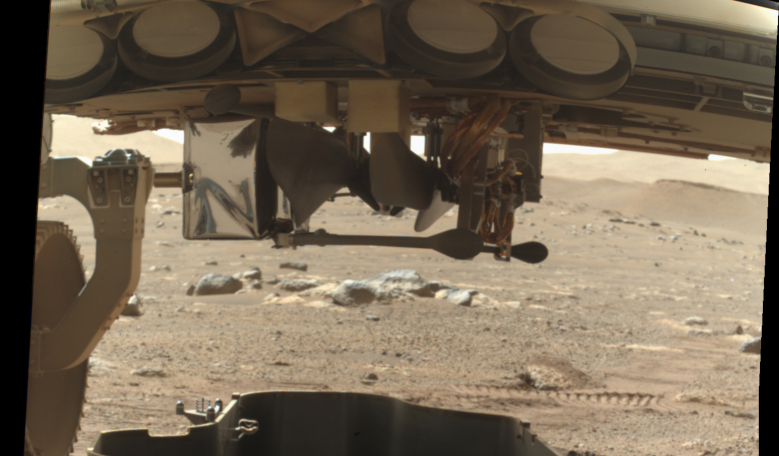NASA’s Perseverance rover released its debris shield yesterday giving eager watchers back on Earth the first glimpse of the first aircraft on Mars, Ingenuity; a move which signals the process of safely delivering the Marscopter to the surface of the planet.
When NASA’s Mars 2020 mission successfully deployed the Perseverance rover on the Red Planet over a month ago, nestled up sideways under its belly and protected by a cover to shield it from the debris kicked up during landing, was a small payload with huge lofty ambitions.
Weighing just 1.8 kilograms, the craft’s body is the size of a box of tissues. It stands on four skinny legs and is topped with four specially made carbon-fibre blades, arranged into two rotors that spin in opposite directions at around 2,400 rpm – many times faster than a passenger helicopter on Earth.
This marvel of engineering is the first aircraft humanity has sent to another planet to attempt powered, controlled flight.
If Ingenuity succeeds in its mission, the experimental flight test data could enable other advanced robotic flying vehicles that might be part of future robotic and human missions to Mars.
Its first objective however, is just to last the night.
In order to work, Ingenuity has to survive frigid temperatures with nights as cold as minus 90 degrees Celsius (minus 130 degrees Fahrenheit) at Jezero Crater.
So far, Ingenuity has been receiving its power from the rover, and a test of its power system conducted one week into its near seven-month journey to Mars, showed that the rotorcraft's six lithium-ion batteries had at least have survived launch.
But, once deployed on Mars' surface, it will be down to the helicopter's own solar panel, which is mounted atop its rotor system, to charge the batteries.
Like its name suggests Ingenuity is equipped with a lot of autonomy to make its own decisions, including how to keep itself warm.
With Ingenuity’s shield dropped, its deployment to the surface is expected in days. If the helicopter can survive the cold Martian nights, the small craft will have a 30-Martian-day (31-Earth-day) experimental flight-test window in which it will attempt a series of 90 second flights. Power expended by the helicopter at the maximum flight time is about 350 watts.
Each flight is planned to be at altitudes ranging from 3 - 5 metres (10–16 feet) above the ground and it could travel as far as 50 metres (160 ft) before heading back to the starting area.
During flights, a one-way data stream will be sent in real time from the helicopter to the rover for storage and subsequent retransmission to Earth. Perseverance will also document the flight tests with its onboard cameras.
Meanwhile the helicopter’s downward-facing black-and-white camera will take images which are used for navigation (determining position and attitude) in real time during the flight.
An horizon-facing colour camera is expected to take a few colour images during flight.
Before that happens, Perseverance will drive to a suitably flat location within a 10-day-drive of the landing site or up to one kilometer away—as the rover is able to travel about 100 metres a day – before Ingenuity is lowered to the surface.
Perseverance will then drive off to a safe distance and will hopefully shoot a video, of what is likely to be one of the most memorable autonomous flights in human history so far.











